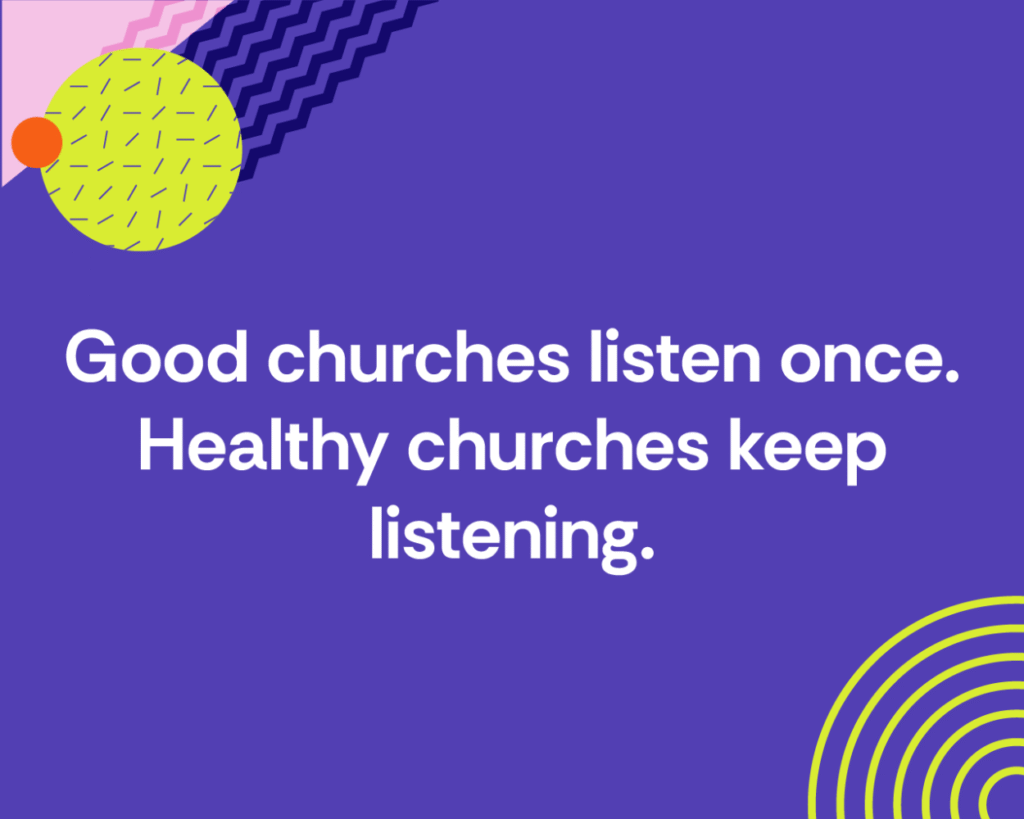This article is part of my series, “Listening as a Ministry Discipline.”
Churches work hard to create welcoming environments. But long-term discipleship isn’t built on first impressions.
What we often miss are the quiet signals that tell us when belonging is slipping — not because of conflict, but because of drift.
And drift is rarely loud.
This is where churches can borrow something from UX research: the practice of intentionally listening for the small, invisible moments that often go unnoticed.

The Hard Part Starts After Hello (After the First Impression Fades)
Most churches are good at first impressions.
The parking team smiles. The lobby feels warm and inviting with free coffee. The kids ministry has friendly volunteers and looks fun and engaging. There’s a welcome gift, a follow-up message, and maybe even a meeting with a pastor.
The front door experience is often designed with great intentionality. And for good reason—those first few visits matter.
…But what happens after that?
Six weeks in, the automated emails stop. The coffee conversations fade. Small group sign-ups feel overwhelming or confusing. Ministry opportunities aren’t always obvious or accessible.
The family who once felt excited to connect with you slowly drifts away.
And this isn’t just a “family” problem—it happens with singles, young adults, older members, new believers, even long-time attenders who quietly start feeling disconnected.
David Kinnaman said it plainly in unChristian:
“Most people in America, when they are exposed to the Christian faith, are not being transformed. They take one step into the door, and the journey ends.”
The welcome and new member phase isn’t the problem.
The problem is what happens after they become a member.
The Silent Drift
Most people don’t leave a church with a dramatic exit. There’s rarely a confrontation. There’s rarely even a sound. Often, no one even notices they’re gone—until long after they’ve quietly slipped away.
The truth is, disengagement rarely happens all at once. It’s gradual. Subtle. Invisible.
They miss a few Sundays. They don’t connect with a small group. They aren’t able to serve in a ministry anymore. They feel on the outside of long-established circles. And eventually… they stop showing up.
We know when people stop attending. We rarely know why they started pulling away.
We can measure attendance. We can track giving. We know how many people fill out a first-time guest card.
But we don’t often measure:
- When people feel uncertain about how to connect
- When big life changes leave them wondering if they still belong
- When trust in leadership starts to fray
- When “busy” becomes a mask for disengagement
As David Kinnaman writes in You Lost Me:
“Much of what young adults experience isn’t overt hostility—it’s simply that they don’t feel needed, wanted, or heard.”
And they’re not alone. Singles, long-time members, new believers, volunteers—all are susceptible to the same quiet drift when no one is listening for the subtle signals.

Churches are good at tracking what’s easy to count. We know how many people attend Sunday services. We can track giving trends, volunteer hours, small group registrations, event RSVPs.
These are important metrics—but they only tell part of the story.
What we often miss are the leading indicators of spiritual disengagement.
The small signals that reveal when someone’s experience starts to misalign with their sense of belonging.
We rarely track:
- The questions that go unanswered.
- The relationships that never fully form.
- The quiet hesitations before joining a group or serving.
- The emotional weight of feeling unseen or uncertain.
State of the Bible 2025 reveals what many ministry leaders feel but often can’t quantify:
- 41% of Americans qualify as Bible users, but only 20% show deeper Scripture engagement
- Even among practicing Christians, nearly a quarter show declining engagement
- Gen Z and Millennials show spiritual curiosity but ongoing gaps in meaningful connection
These aren’t just statistics—they’re signals of disconnection beneath the surface.
In UX research, we call this behavioral friction. Small moments that create drag, confusion, or hesitation.
In ministry, these friction points often go unmeasured. Not because they’re unimportant—but because we’re not intentionally listening for them.

Why UX Research Belongs in Church Contexts
When churches think about research, we often default to surveys, attendance tracking, or program evaluations. But that’s not the same as understanding people’s real experiences.
UX research (user experience research) exists to surface exactly these kinds of invisible barriers.
It’s not just about improving apps or websites. It’s about uncovering where people:
- Struggle to navigate complicated next steps (like small groups, volunteering, discipleship, or serving)
- Don’t know what step to take next
- Experience subtle friction that wears down engagement
- Quietly wonder, “Do I still belong here?”
Churches often assume that good intentions will naturally carry people forward. But intentional design matters just as much as intentional content.
UX research offers ministry leaders tools to make those invisible experiences visible:
- Journey mapping — Visualizing how people move through the church experience from visitor to connected member to leader.
- Exit interviews — Quietly listening to why people disengage before they fully leave.
- Feedback loops — Asking for input at key moments (3 months, 6 months, 12 months into involvement).
- Friction audits — Identifying confusing processes, overwhelming next steps, or relational breakdowns.
As You Lost Me describes, many young adults aren’t rejecting faith out of anger—they’re quietly disengaging because they don’t feel seen or needed.
“What makes this disconnection so challenging is that most churches aren’t even aware of it.”
UX research offers a ministry practice of ongoing listening. Not once. Not annually. But continuously.
Ministry isn’t just about inviting people—it’s about staying aligned with them over time.
The early excitement of a new church experience fades quickly if people aren’t continually seen, heard, and shepherded. What begins as intentional hospitality too often shifts into silent assumption: “They’re here, so they must be connected.”
But ministry requires ongoing listening. Because people’s needs change. Their circumstances change. Their sense of belonging shifts as they move through different life stages, struggles, and questions.
In UX research, we never assume the system is perfectly aligned just because it’s functional. We build feedback loops into the process—small, continuous ways to check whether what we’ve built is still serving people well.
Churches need these feedback loops, too.
Not to micromanage programs. Not to control outcomes. But to practice stewardship—caring well for the people entrusted to us.
Regular listening might look like:
- Quiet check-ins with newer members after a few months.
- Honest exit conversations when someone steps away.
- Ongoing feedback from volunteers about where they’re thriving—or quietly struggling.
- Periodic reflections with small group leaders to surface emerging needs.
Good churches listen once – Healthy churches keep listening.
Because listening isn’t just good leadership. It’s spiritual care.
Listening as Stewardship
Discipleship isn’t a one-time class. Belonging isn’t a one-time invitation.
The most significant moments that shape someone’s spiritual life often happen between the visible markers churches are used to tracking.
We can’t disciple people we aren’t listening to. And we can’t listen well if we aren’t intentionally looking for the quiet signals of drift.
This is where UX research offers more than just methods. It offers ministry leaders a posture of ongoing care—an intentional, quiet, structured way of asking: “Is this still serving the people we’re called to serve?”
UX research doesn’t replace spiritual leadership. It simply helps us see where alignment is slipping before it becomes absent. It gives us tools to notice disconnection before it turns into departure.
Because ministry isn’t just about what we teach. It’s about how people experience belonging.
And that starts with listening.
References:
- Kinnaman, David & Lyons, Gabe. unChristian: What a New Generation Really Thinks About Christianity… and Why It Matters. Baker Books, 2007. Available at: https://www.amazon.com/dp/0801013003
- Kinnaman, David. You Lost Me: Why Young Christians Are Leaving Church…and Rethinking Faith. Baker Books, 2011. Available at: https://www.amazon.com/dp/0801013143
- American Bible Society. State of the Bible 2025: Insights and Trends from America’s Engagement with Scripture. American Bible Society, 2025. Available at: https://www.americanbible.org/news/state-of-the-bible/
